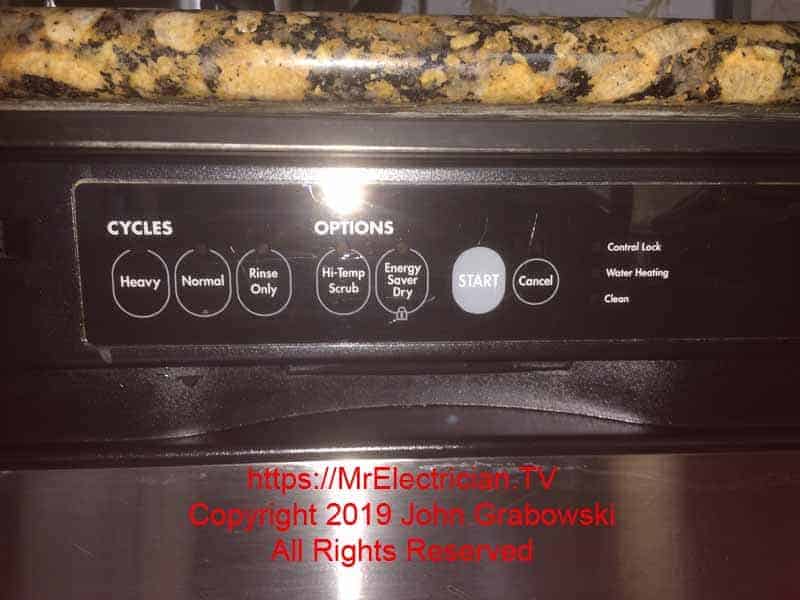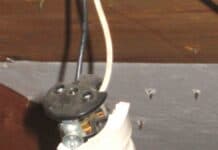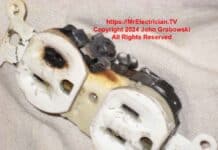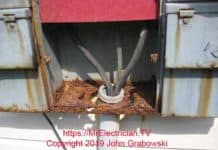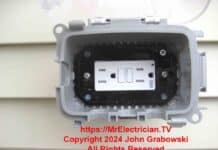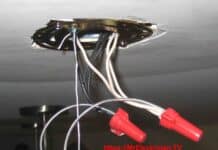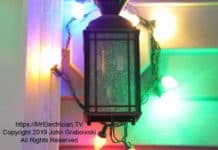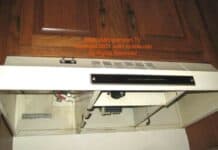Dear Mr. Electrician: How do I go about testing my dishwasher appliance for power? Last night, I tried to wash dishes, but nothing happened. There were no sounds or visible indicator lights.
Answer: Testing a dishwasher appliance for power is a good starting point. However, an appliance such as a dishwasher usually requires the services of an appliance technician for repair and not the expertise of an electrician.
Table of Contents:
NOTE: Some text links below go to applicable products on Amazon. As an Amazon Associate, I earn from qualifying purchases. Using my links helps to keep this website FREE.
TESTING A DISHWASHER APPLIANCE FOR POWER
First, make sure that the fuse or circuit breaker is not off. Go to your home’s main fuse box or circuit breaker panel and reset the circuit breaker for the dishwasher by pushing fully to the “Off” position and then to the “On” position.
If you don’t know which circuit breaker is for the dishwasher, reset them all. If you have fuses instead of circuit breakers, replace the fuse for the dishwasher. Now check to see if the dishwasher is working again.
If resetting the circuit breaker or replacing the fuse does not get the machine running again, you will need to look inside the dishwasher. Start by removing the bottom front cover to expose the components of the dishwasher. This is usually accomplished by removing a few screws on each end or pushing some clips to release the panel.
It is also possible that the bottom cover is just hooked in place and only needs to be lifted for removal. The dishwasher owner’s manual may have detailed steps for the cover’s removal.
CLICK HERE to see Dishwashers on Amazon
You must get down on the floor to work inside the dishwasher. A furniture pad or blanket on the floor will make it more comfortable. Remove the cover in the toe kick area under the dishwasher’s door. Sometimes a screw at each end will need to be removed. On other model dishwashers, the toe kick cover snaps in and is removed by pushing the clips in or down.
At the bottom of the dishwasher, you should see a small electrical box with a cord or cable going into it. Use a Non-Contact Voltage Tester and touch the side of the cord or non-metallic cable to see if there is electricity. The non-contact tester will not work properly with a metal jacketed cable such as Type AC (BX) or Type MC cable.
If the non-contact tester indicates voltage on the cord or cable, you should shut off the power at the fuse box or circuit breaker panel. Remove the fuses or shut off the circuit breakers until the non-contact voltage tester indicates no power.
With the power to the dishwasher turned OFF, remove the cover on the small electrical box on the bottom, not inside where the dishes get washed, but underneath. Double-check the wires inside the small electrical box with the Non-Contact Voltage Tester. If it still indicates that there is no voltage present, then disconnect the white and black wires.
Using a pigtail socket with an ordinary working light bulb, connect the pigtail socket wire leads to the cable or cord coming into the dishwasher electrical box. Cover the ends with wire connectors so no bare copper wire is exposed.
Now turn back the power to the dishwasher at the fuse box or circuit breaker panel. If the light bulb lights up, then you have confirmed that the dishwasher is getting power and that the problem is internal and will require the expertise of a qualified appliance technician. Shut the power off, remove the pigtail socket, and reconnect the wires inside the dishwasher electrical junction box as they were.
If the pigtail socket light bulb does not light up after turning the dishwasher back on, you may have an electrical problem causing the dishwasher not to work.
You must open up the fuse box or circuit breaker panel to determine why the dishwasher is not getting power. Do not do this unless you are comfortable working around exposed live electrical parts and have the proper tools, safety equipment, and knowledge.
Leave the pigtail socket connected to the cord or cable supplying power to the dishwasher. Remove the front cover to the fuse box or circuit breaker panel. Using a voltage tester with wire leads or another pigtail socket with a light bulb, check to ensure that electricity is off on each circuit breaker or fuse.
Hold one lead of the tester on the neutral bar where all of the white wires are connected, and use the other lead to touch each screw terminal on the circuit breakers or fuse sockets.
If you find no electricity coming off of one of the circuit breakers or fuses, you may have found the root cause of why the dishwasher is not working. Using an insulated screwdriver, tighten the screw connection on the circuit breaker or fuse that is not working. Also, tighten all other connections on the fuses and circuit breakers.
Tighten all of the connections on the neutral bar and ground bar. A loose connection could affect the performance of your dishwasher.
After tightening everything, check for voltage again at the circuit breaker or fuse. If you still do not have power, replace the circuit breaker or fuse or have an electrician do it.
If there is still no power at the dishwasher, even though all fuses or circuit breakers have power, there may be an electrical problem in the circuit wiring. A loose connection could be in a remote junction box or a receptacle wall box. A wire may have been cut due to some recent renovation activity.
Some shoddy wiring installed in the walls years ago may have finally failed. These are more difficult to find and correct because it entails opening up receptacles, switches, junction boxes, and sometimes walls to track down the problem.
I would start at the dishwasher and find where the wire that supplies power goes. It could come from a kitchen electrical receptacle outlet. You would have to open up each outlet to find out which feeds the dishwasher.
I got a call from a regular client telling me she was getting a new dishwasher and needed me to come over to disconnect the power from the old one and connect it to the new model.
First, I opened the tow kick panel and then the little junction box where the electrical connections were made. I used my non-contact voltage tester and confirmed that the power was still on. I flipped off a couple of circuit breakers to identify the dishwasher circuit and then disconnected the wire from the old dishwasher.
I then pulled that wire through into the adjacent cabinet, so I could use it to power a new GFCI electrical outlet. I put the new outlet box together, mounted it inside the cabinet, and then turned on the circuit breaker.
Using my non-contact tester again on the cable going into the box, I could confirm that power was back on. Next, I plugged in my receptacle outlet tester to check polarity and test the GFCI. The circuit went dead when I plugged my outlet tester into the GFCI outlet.
It turns out that, in this instance, the circuit breaker was bad and only worked intermittently. The client assumed that the dishwasher was bad and ordered a new one. Had she called an electrician or an appliance technician, both of them would have gone about testing a dishwasher appliance for power.
GFCI OUTLET FOR DISHWASHER
The National Electrical Code (NFPA 70) now requires that a dishwasher have GFCI protection. Read article 422.5. It also allows a dishwasher to be powered through a plug-in cord instead of being hardwired. This makes servicing and replacing the dishwasher a little easier and safer. See article 422.16(2).
By having the dishwasher plugged in, you no longer need an electrician to come and disconnect the old dishwasher and connect the new one.
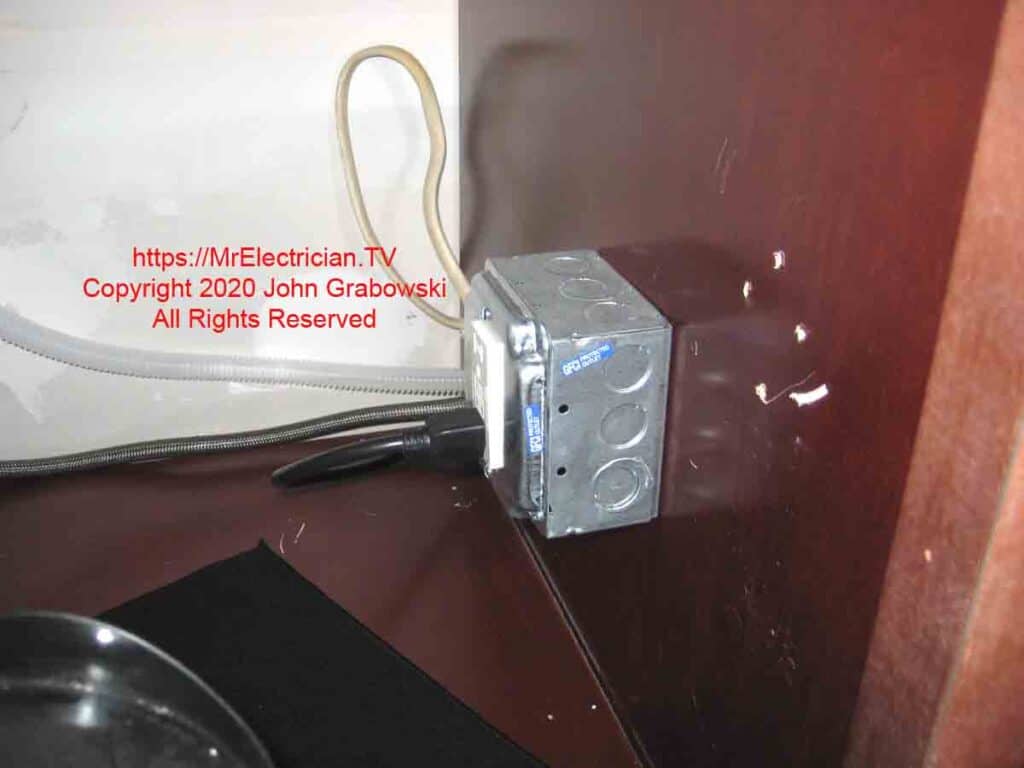
The outlet inside the cabinet above was installed for a replacement dishwasher in an existing kitchen. The wire initially connected directly to the old dishwasher was rerouted into the adjacent cabinet.
A four-inch square box was installed on the wire, and the bare ground wire was screwed to the box with a pigtail wire hanging loose to attach to the GFCI. The connections were made on the receptacle before the box was mounted to the side of the cabinet.
The 4″ square cover was attached to the GFCI receptacle, then the box was mounted using an impact driver, and the cover was attached. It was easier pulling the wire out further to work on it than crawling inside the cabinet.

You may have encountered some phantom voltage when troubleshooting the dishwasher. Read my article to explain it.
Click Here to read my article about installing microwave ovens over stoves.
You can see all of my blog posts about kitchens by clicking here.
Click here to see the kitchen-related topics on This Old House.
To help keep this website free, please use this Amazon link for your purchases. As an Amazon Associate, I earn from qualifying purchases.
Click here for a FREE copy of my book “Almost Everything You Need To Know To Repair a Bathroom Exhaust Fan In Your Home.”
Get your required “Emergency Disconnect, Service Disconnect” labels and stickers to satisfy the 2023 National Electrical Code requirements in article 230.85(E)(1) and (2) by going to my Redbubble Shop here.
Visit my Link Tree for my social media connections.
